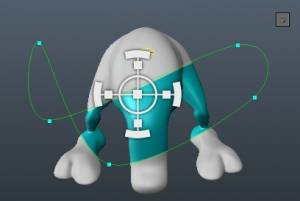Κοντά στα σημεία ελέγχου, θα δείτε το αναπτυσσόμενο βέλος που συνοδεύει τον σχεδιασμένο spline. Πατήστε το και θα μπορείτε να επιλέξετε διαφορετικές επιλογές από ένα εκτεταμένο μενού εντολών:
Εφαρμογή: Εφαρμογή δράσης spline. Μπορείτε να χρησιμοποιήσετε το ENTER. Με πατημένο το CTRL, θα αντιδράσει.
Clear: Διαγράψτε όλα τα σημεία ελέγχου.
Αποσύνδεση από επιφάνεια: Αυτή η εντολή αποσπά κάθε σημείο ελέγχου που προσαρτάται σε μια επιφάνεια (ένα σημείο ελέγχου προσαρτάται εάν το προσθέσετε ενώ ο κέρσορας βρίσκεται πάνω από την επιφάνεια).
Το διάστημα μετακινεί το σχήμα στο χώρο της οθόνης. Στερεώστε σημεία στην επιφάνεια έτσι ώστε η ράβδος να περιστρέφεται μαζί με το μοντέλο.
Το διάστημα μετακινεί το σχήμα στο χώρο της οθόνης. Χρησιμοποιήστε αυτήν την εντολή εάν πατήσατε ESC αφού προσθέσατε σημεία ελέγχου και αποφασίσατε να συνεχίσετε. Πατήστε ESC για να τελειώσετε.
Επεξεργασία σημείων: Αυτή είναι μια προεπιλεγμένη λειτουργία αφού ολοκληρώσετε την προσθήκη σημείων ελέγχου. Τοποθετήστε το δείκτη του ποντικιού πάνω από έναν spline στο σημείο όπου θέλετε να προσθέσετε ένα άλλο σημείο ελέγχου (όταν δείτε ένα κόκκινο σημείο, πατήστε LMB για να το προσθέσετε). Σύρετε οποιοδήποτε σημείο ελέγχου με το LMB. Χρησιμοποιήστε το RMB πάνω από οποιοδήποτε σημείο ελέγχου για να αλλάξετε την ευκρίνεια κορυφής.
Μετασχηματισμός όλων: Μεταμορφώστε ολόκληρη τη σφήνα με το χειριστή (περιστροφή, κίνηση, κλίμακα κάθετα, οριζόντια, αναλογικά).

B-Splines: (επισημαίνονται). Χρησιμοποιήστε το B-Splines από προεπιλογή. Σε αυτήν τη λειτουργία, η πλάκα θα είναι πιο ομαλή και δεν θα διασχίζει τα σημεία ελέγχου. Χρησιμοποιήστε το με ευκρίνεια κορυφής για να λάβετε διάφορες μορφές.
Απόκρυψη βοηθητικών γραμμών: Απόκρυψη γκρίζων γραμμών που συνδέουν σημεία ελέγχου.

Επεξεργασία πίνακα σημείων: Ορίστε αριθμητικές τιμές για κάθε σημείο ελέγχου. Σε αυτό το παράθυρο, μπορείτε επίσης να ορίσετε τον τύπο κάθε σημείου ελέγχου: αιχμηρό (κάνει μια ευκρινή γωνία σε αυτό το σημείο), B-spline (απλή spline αν δεν είναι επιλεγμένη).

Κλίμακα: Ρυθμίστε τον παράγοντα κλίμακας και πατήστε το κουμπί «OK» ή ENTER.
Περιστροφή: Ρυθμίστε τη γωνία περιστροφής και πατήστε το κουμπί “OK” ή ENTER.
Αναποδογυρίστε οριζόντια: Αναποδογυρίστε ολόκληρο το spline οριζόντια.
Αναστροφή κατακόρυφα: Αναποδογυρίστε ολόκληρη τη λωρίδα κάθετα.
Αποθήκευση…: Αποθήκευση του spline σε ένα αρχείο.
Φόρτωση…: Φόρτωση προηγουμένως αποθηκευμένου spline από ένα αρχείο.
Σας επιτρέπει να αποθηκεύετε και να φορτώνετε προφίλ καμπυλών. Αυτό είναι ένα πολύ ισχυρό χαρακτηριστικό, καθώς μπορείτε να import αρχεία EPS, μεταξύ άλλων τύπων αρχείων, με διανυσματικά γραφικά για χρήση ως μέρος ενός Brush στα δωμάτια Paint ή Sculpt. Μπορείτε επίσης να αποθηκεύσετε τα προφίλ καμπυλών που έχουν δημιουργηθεί σε 3DCoat, να τα φορτώσετε ξανά αργότερα ή να τα μοιραστείτε με άλλους.
– Τα αρχεία υποστήριξης για αποθήκευση είναι: EPS, Spline (ιδιόκτητο αρχείο 3DCoat )
– Τα υποστηριζόμενα αρχεία για φόρτωση είναι: EPS, Spline ( ιδιόκτητο αρχείο 3DCoat ), TGA, BMP, PNG, JPG, DDS, TIF/TIFF, EXR, HDR.
Εφαρμογή Brush “Dabs” with Spacing: Αυτό κάνει το τρέχον Brush να ανταποκρίνεται ιδιαίτερα στις επιλογές “Dabs, Jitter, and Spacing” που βρίσκονται στον πίνακα “Brush Options”. Ο πειραματισμός δείχνει αυτή τη δράση καλύτερα.
 Ελληνικά
Ελληνικά  English
English Українська
Українська Español
Español Deutsch
Deutsch Français
Français 日本語
日本語 Русский
Русский 한국어
한국어 Polski
Polski 中文 (中国)
中文 (中国) Português
Português Italiano
Italiano Suomi
Suomi Svenska
Svenska 中文 (台灣)
中文 (台灣) Dansk
Dansk Slovenčina
Slovenčina Türkçe
Türkçe Nederlands
Nederlands Magyar
Magyar ไทย
ไทย हिन्दी
हिन्दी Tiếng Việt
Tiếng Việt Lietuviškai
Lietuviškai Latviešu valoda
Latviešu valoda Eesti
Eesti Čeština
Čeština Română
Română Norsk Bokmål
Norsk Bokmål